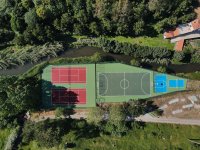Camping in Porto and The North
1 campsite in Portugal, Porto and The North for Porto
Campsite Listing Google Map
The following consent is required:
Tracking & performance, Targeting & advertising.
Porto and The North
The North of Portugal is a region steeped in history, originally inhabited by Celtics, Romans and Moors. Renowned for its beautiful countryside, the River Douro winds its way past mountains, valleys, vineyards and cliffs until it reaches the sandy beaches of the Atlantic coast near the city of Porto.

Situated in the northwestern corner of Portugal, the Costa Verde boasts lush green pine forests and unspoilt sandy beaches dotted with picturesque seaside villages, including Caminha and Vila Nova de Cerveira. It is also renowned for its wine, being the home of Port and Vinho Verde. Located on the banks of the River Douro, the attractive city of Porto is the centre of the Port wine trade – free tastings are offered at the wine cellars in Vila Nova de Gaia – and terraced vineyards can be found across the Douro Valley. The region is also a perfect place for walking, mountain trekking, canoeing, or simply relaxing in the spa towns of Carvalhelhos, Chaves and Pedras Salgadas. Vidago has a magnificent park with swimming pools and a golf course, while the mountains of Peneda, Soajo and Gerês form the Peneda Geres National Park, an area covering 170,000 acres with an abundance of wildlife. Vila Nova de Foz is the centre for visits to the Côa Archaeological Park, which houses one of the world’s largest collections of outdoor Palaeolithic rock art, dating back 22,000 years.
The region comprises of five areas: Braga, Braganca, Porto, Viana do Castelo and Vila Real.

Places of interest
Barcelos: Medieval walled town with dungeon, ceramics museum, archaeology museum.
Bragança: Medieval castle and walls, 16th-century cathedral, railway museum with 19th-century locomotives and carriages.
Chaves: Roman bridge, 14th-century castle with Archaeology and Epigraphy Museum.
Guimarães: Medieval castle and walls, palace.
Lamego: Medieval castle, 12th-century fortress.
Ponte de Lima: Beautiful small town, Roman bridge, medieval towers, manor houses.
Viana do Castelo: Town famous for its handicrafts and colourful regional costumes.
Vila do Conde: Ancient medieval shipyard, famous for its manufactured lace.
Cuisine of the region
Typical dishes include bacalhau (dried and salted cod), rabanadas, papos-de-anjo and barrigas-de-freiras (sweetmeats). Porto has its own tripe dish, Tripas à moda do Porto. The Minho region is renowned for its Vinhos Verdes, whose vines are grown on trellises (suspended high in the air on special frames). In the Douro region, the vines are grown on terraces, giving the impression of huge, natural staircases leading down to the banks of the river. Both red and white wines are produced here including the famous Vinho do Porto (Port wine).
Caldo verde: Thick soup made with green cabbage, potatoes and spicy sausage.
Feijoada à transmontana: Bean stew.
